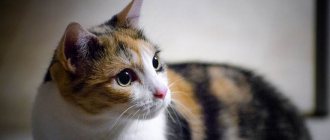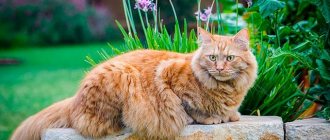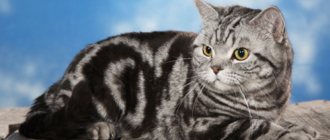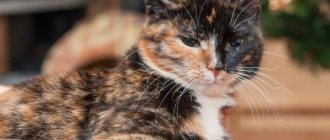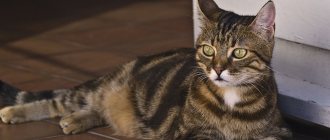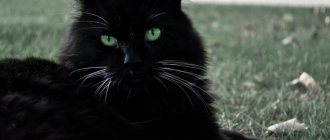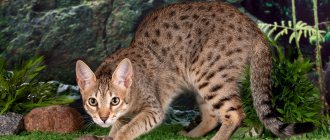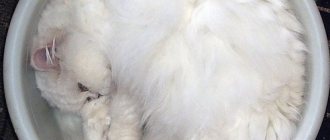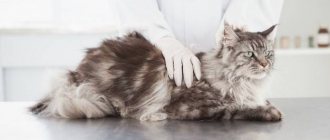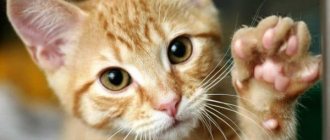Even a black cat has stripes, but they are not visible. Tabby cats are found in almost all breeds, regardless of pedigree. Sometimes, due to its association with the coloration of predators, this coloration is called “wild”.
And although there is an abyss between the appearance of the giant Maine Coon and the graceful toyger, the pattern on the fur still unites them into one group.
Genetics of tabby cat color
Eumelanin and pheomelanin are the two main pigments (black and red) that create the entire palette of cat colors. The next important gene attribute is T (tabby), it is responsible for the labyrinth of stripes or the orderly arrangement of spots.
Tabby exists in 3 types (alleles):
- Ta - there is no pattern on the fur, and each hair contains pigmentation of several shades of color (ticking).
- Tm – classic tiger lines, consisting of stripes of arbitrary length and shape.
- Tb – marble effect from blurred borders of the picture.
The spotted color does not have its own allele. It is considered to be derived from Tm, involving polygenic (embedded in other genes) structures.
All cats have a T genotype, but it doesn’t work for all of them. For a tabby to show natural qualities, another component is needed, gene A (agouti), which is responsible for dividing the hairs into dark and light areas.
The alternation of these boundaries can be arbitrary, but the pattern is duplicated on each hair. Nature loves balance and the aa (non-agouti) allele serves as a counterbalance. It suppresses the properties of the T (tabby) gene and creates a continuous, non-pigmented hair color.
All-striped cats with the agouti trait are grouped into the tabby group. This means that their soft coat has a contrasting or shaded pattern of various sizes and configurations.
This is interesting: in white cats the W gene dominates, blocking the penetration of pigment into the hairs. Therefore, white cats cannot be tabby even in hidden form.
BRITISH TABBY KITTENS
British tabby kittens can only be born from parents of this color. Those. at least one parent must be a tabby (with a pattern). A British tabby/tabby kitten should have a fairly contrasting pattern from birth. It must be remembered that over time, the color of British tabby cats “erodes” as the kitten grows, so, for example, a brindle color can turn out to be a spotted color. The full tabby color of British cats is formed by one year.
| In our cattery you can “buy a real British kitten.” We have many different colors, we will help you choose and answer all your questions! |
| Please rate the article! (1 star - didn't like it, 5 stars - liked it) Thank you! |
Features of tabby cats
There are exceptions to every rule - the striped pattern also confirms the universal truth. The power of gene A was challenged by gene O. In a cat’s body, it is responsible for the red (red) color and is unique in that it is attached only to the X chromosome. And it, in turn, divides cats into boys (XY) and girls (XX).
Let’s leave aside the very mechanics of the origin of the red color, but let’s conclude that a red cat is always a striped cat, because the O (red) gene suppressed the aa (non-agouti) allele and made room for the T (tabby) gene.
Stripes can be tiger, shaded marble or in the form of random spots. Sometimes a tabby kitten is born with a clear pattern, but later loses the contrast of the pattern. But it happens the other way around - tabby clearly manifests itself only after reaching puberty.
Important! Cat striping has its own hierarchy. In it, the ticked Ta allele suppresses the tiger coloring Tm, and the marble pattern Tb is in last place.
Noah's Ark didn't carry cats.
Everyone knows about the purpose of the legendary Noah's Ark. This huge ship became a salvation for all types of animals. Only there were no cats then, and therefore they were not on Noah’s ark. As the legend says, during the long voyage, animal excrement began to greatly interfere with normal existence.
Mice and rats multiplied at such a speed that food supplies might not be enough until the end of the voyage, since the rodents ate everything. People and animals were threatened with terrible starvation, and God himself again came to the rescue. He told Noah to stroke the elephant's trunk, and at the same moment a pig appeared from the trunk, it destroyed all the fetid excrement. Then Noah, again on the advice of the Almighty, stroked the lion's nose, and a cat appeared from it. It was she who saved the inhabitants of the ark by catching all the mice.
Varieties of colors
How many cats - so many fur coats. Breeders are constantly experimenting with colors. They cross two parents with the desired traits and strive to imprint some exotic shade in the offspring. In this case, an arbitrary uncontrolled mutation occurs along the way, which can radically change the appearance of the animal.
It has been noticed that many breeds of tabby cats have a stable nervous system and good health. No one has yet proven a direct relationship with the type of color, but scientists are also in no hurry to deny it.
The tabby allele is located on the cat chromosome 1X, which is responsible for the immune system. A random change in the established order can destroy the natural balance.
The cat with dark stripes is found in many breeds. This pattern is also called tiger because of its external resemblance to a wild predator. The only difference is the base coat color, but the gray tabby's pattern looks identical.
Distinctive features:
- the neck is girded with narrow lines;
- thin stripes of varying lengths are located throughout the body;
- the tail is ringed along the entire length or most of it.
The name of the color must indicate the color of the ornament, and not the characteristics of the coat:
- Black tabby cat with dark lines on its skin.
- Red brindle with a pattern in shades of red.
- The blue brindle is painted with blue-gray strokes.
- The brown tabby cat has a chocolate-colored labyrinth on his skin.
Gray tabby cat species are found primarily in native breeds. Their appearance corresponds to the conditions of natural selection, living in a certain area in a natural climatic environment.
But it is almost impossible to find a pet with stripes of exotic colors (fawn, cinnamon, lilac) among gray purebred cats.
Preview:
Summary of productive drawing activities in the younger group
"Rug for cats - Murki"
Continue drawing straight horizontal and vertical stripes on the piece of paper, placing them at the same distance.
Strengthen your drawing skills. Train children to hold the brush correctly, pick up paint with the entire bristle of the brush, remove an extra drop on the edge of the jar, rinse the brush, use a cloth.
Develop an interest in drawing. Cultivate accuracy, independence, and the desire to draw.
Preparation for the lesson:
Preliminary work with children: examining patterns on different rugs or napkins.
Materials and equipment: a toy cat, 3 large samples of rugs (different in the arrangement of elements), an easel for demonstrating drawing methods, gouache, a table. For children, tinted paper, a picture of a cat for each child, brushes, jars of water, rags.
Methodology of conducting the lesson:
The teacher calls the children to come to him (to free space).
- Look, guys, what kind of cat came to visit us! Her name is Murka. Let's say hello to her. Murka is a very cheerful cat, she wants to play with you. She will chase you, and you will run away.
Outdoor game "Cat and Mouse"
The teacher with the cat catches the children (mice). The game is repeated (2-3 times).
- Teacher - (cat) after playing. Guys, our cat is tired and wants to rest. Here's a rug for you, Murka, lie down and rest.
The teacher places a sample rug on the table and places Murka on it.
– There is a small cat on everyone’s desk. Do you guys want to draw beautiful rugs for your cats? Then sit down at the tables.
The teacher hangs 1 more sample on the easel.
- Guys, tell me, what is the rug decorated with? (Lines).
– How are the lines located? (At the same distance).
- What color are they? (Multicolored)
– How are the rugs different? (If the children do not say, then the teacher himself compares - the location of the lines and the color).
– And now I’ll show you how to draw such beautiful rugs.
Show the teacher, pay attention to working with gouache, talk through all the actions.
– You can arrange the lines in different ways, and you can choose any color. Let's draw carefully guys. We are trying! So that your cats can rest with pleasure on beautiful rugs.
Part II – Independent work of children
Samples hang on an easel.
– individual display (only on the teacher’s leaflet);
- at the end of the work, playing out;
Part III – Review of works
Examine the rugs with the children and praise all the children.
-Educator: As soon as the rugs dry, your cats will lie down on them to rest and will see beautiful, different dreams.
The most famous breeds of tabby cats
Tabby animals can be present in almost any cat group. Even on the spots of the tortoiseshell tricolor, a pattern appears. In some breeds, striping has become the main distinguishing feature, which is indicated in the name.
Asian tabby
This breed is not widespread. It was originally known as the "Asian cat", but was later renamed the "Asian tabby" due to its color.
The dominant coat colors are presented in the following shades:
- blue;
- red;
- smoky;
- black;
- tortoiseshell tricolor.
The breed standard provides the following pattern options:
- Ticked - the wool is dyed in zones, there is a contrasting accent on the guard hairs.
- Brindle – dark parallel lines are located vertically on a light base color.
- Marble - spiral-shaped strokes are symmetrically located on the sides.
- Spotted – “blots” are placed throughout the body in a random order.
For Asian tabbies, the presence of a pattern on the body is mandatory, and for representatives of the ticked group - on the face.
Cymric: tailless and striped
Another rare semi-longhaired cat, which is still not recognized by some felinological organizations. Selection was carried out in Canada by selecting Manx kittens, discarded because of their long hair (not to be confused with the Manx raccoon cat, Maine Coon).
Among the colors of fluffy Cimmerian cats there are all variants of standard colors: black and red. They are often combined with white or appear as a tricolor. Marble or tiger stripes usually stand out clearly against the main background.
Pixie bob: lynx in cat skin
The breed was developed by crossing a domestic cat and a wild short-tailed forest cat. The standard provides for a gray (mouse) color with intense ticking.
The eyes are outlined with a contrasting edging of white or cream. Small and medium-sized tabby spots are randomly scattered throughout the body. Even the stomach is covered with the pattern.
Maine Coon: descendant of the Manx raccoon
A large representative of the cat family (the weight of a Maine Coon sometimes exceeds 10 kg, and its body length is usually at least 1 m). It is not difficult to meet a large gray tabby Maine Coon cat; for this breed, such a pattern is the norm.
Often you come across red tabbies with white accents on the chest and tips of the paws. Although experts initially considered only brown tabby cats, over time the palette expanded.
The appearance of unusual shades (cinnamon, lilac, chocolate) indicates a crossbreed and is not recognized by some felinological organizations.
Toyger: toy tiger
The name of this animal encodes the color features (toy, tiger). Stripes all over the body, paws and tail really make the miniature cat look like a real predatory animal. According to the standard, dark stripes must be positioned vertically, and longitudinal lines are prohibited.
Soukok - striped animals from Africa
Cats and cats with tabby tails are native to Africa. There is a common version of their origin - their ancestors were brought by colonists from Europe. Later, having reached Kenya with settlers, these animals began to explore new territories. As a result, they adapted to life in the tropics. Short-haired. Medium weight. They are ordinary cats by nature.
Mongrel tabby cat
Most tabby cats can be found among outbred pets. Breeders have never worked on the appearance of such animals, so all their natural qualities have been preserved in their original form.
An outdoor cat can be classified as a ticked tabby with the Tm allele, the agouti trait instruction, and the O gene attached to the X chromosome. In practice, this will mean that a gray striped cat will have striped offspring for a long time.
And who knows, maybe snow-white albinos look at this natural greatness and really want to become the same. Because all cats' ancestors were tabby.
Pleasant surprises
If a person is a cat's favorite, then success awaits him. It is a very good sign to feed striped stray cats. Such actions will lead to pleasant surprises. This could be an unexpected income, a pleasant meeting with an old friend, or a romantic surprise.
How to survive the death of a cat: 4 useful recommendations from psychologists
Animals always bring joy to the house. And if you want your home to be filled with comfort, happiness and joy, be sure to bring your striped friend there.
Cats came from the cat planet
I would like to believe in the unearthly origin of cats. The first images of these creatures appeared in Egypt, and there is a myth that it was in Egypt that the first cat aliens arrived. They were completely bald and could communicate with people with the power of thought.
As the legend says, one of the cats wandered into the forest and met there an ordinary and shaggy steppe cat. They fell in love with each other, and the bald cat refused to leave the Earth, she chose love. The couple was happy throughout their cat life, and they produced furry offspring that became the ancestors of today's domestic cats.
NASA says aliens look like cats
Perhaps it was not for nothing that in the Middle Ages people believed that the cat was an unearthly creation. Not long ago, everyone was stunned by the news about the discovery of American astronauts. The guys landed on the moon and found many unusual objects there. They resembled small coins in size. Having brought the artifacts with them, the astronauts sent them to the laboratory. The result of the analysis simply shocked everyone: a similar composition exists on Earth, this is cat feces. Well, tell me, where did they come from on the Moon?
Since then, NASA scientists began to develop the hypothesis that cats are real aliens and all aliens look exactly like this!
Norwegian forest
A large, strong, muscular, very agile cat in a luxurious, very dense coat with water-repellent outer hair covering the back, sides and tail. Breed standards allow many colors, but tabby is one of the most common and, admittedly, the most “suitable” to their harsh appearance.
The ancestors of the Norwegians are feral domestic cats, inhabitants of the forests of Scandinavia for hundreds of years. How they got to those harsh lands is not known for certain. Research has only proven their relationship with Turkish Angoras.
The Norwegian Forest cat is not an old breed, although ideas about its selection appeared back in the 30s of the last century - when it became obvious that the cats of the Scandinavian forests were in danger of extinction. But the breeding program was developed only in the 70s, and was quite successful. Now Norwegians are recognized throughout the world and are the pride of Norwegian breeders (hence the name).
Character
There is a theory that the character of a cat is determined not only by heredity and the owner’s upbringing, but also by its external color. For example, specialists working at animal shelters say that tortoiseshell cats have a complex disposition and temperament, are restless and listen to few people. The presence of white color gives a “calming effect”, and red tabby cats are the most energetic and interesting in their behavior, but sometimes arrogant and hot-tempered.
The peculiar “camouflage” of cats with a tabby pattern is considered the natural color of these animals, since their ancient ancestors - wild cats - this appearance allowed them to hide among trees and grass not only in order to quickly track down and successfully attack prey, but also in order to hide from danger. “Wild” roots have left their mark on the character and behavioral characteristics of our domestic tabby pets: such cats have an excellent hunting gift, have a strong immune system and a first-class level of health, low allergenicity rates, and therefore invariably show dexterity and activity.
In childhood, tabby kittens love to play, they are interested in everything bright and unusual, but when it comes time to grow up, with age comes moderate calmness, as well as equanimity. Independence from the owner's opinion is manifested in the fact that the pet will decide for itself where and when to sleep, even if it has the most beautiful house. The same condition applies to food.
Negative character traits of a tabby include a tendency to “mischief,” stubbornness, capriciousness, and impatience with the owner’s “lectures and reprimands.” That’s why don’t be surprised or nervous if:
- they will scratch furniture, despite the presence of a scratching post in the house;
- when you return home from work, you will see pots of plants fallen from the windowsill or overturned;
- for a while you won’t find your favorite bright pen, pencil or jewelry;
- the cat refuses food for the first time (she can simply show her character and test how pliable you are in relation to her; if she gets hungry, she will come running like a cute little thing).
Breeds of tabby cats are the type of homebody animals; they are not often eager to find out what is happening there, beyond the horizon. And marble tabbies are considered a real symbol of home warmth and comfort. All of the above signs relate to the general behavioral characteristics of purebred tabby cats, and now we will look at what character traits ordinary tabby or spotted mongrel cats have. First of all, these are the following features:
- extreme curiosity, activity, impatience;
- sometimes disobedience, but awareness in inflicting punishment;
- intelligence and cunning;
- low level of resentment;
- cheerful and cheerful disposition.
For the most part, representatives of the “wild” color are the most viable and resistant to diseases among other representatives of the world of domesticated cats. If you decide to get yourself, for example, a gray tabby kitten, be patient and understanding, as they have slight problems with discipline and obedience to their owners. If you do not stop some kind of pampering in time, then soon your pet will simply stop responding to your comments, and will even allow itself to leave in the middle of the procedure for conducting an educational conversation.
Toyger
Of course, this is the most striped of all cat breeds, as can be seen from the name (“toyger” in English - tiger). The toyger is a cat of medium size and build, with superbly developed muscles, an elongated muzzle and clearly visible anus, which is why the shape of the head is similar to an inverted pear, small eyes and ears with rounded tips.
Of course, the main goal of selection is the quality of wool and color as close as possible to tiger. Breeders do everything possible to achieve it. The fur of toygers is short, thick, shiny, the stripes on the coat should be located vertically. The standards allow only one color: brown (black) tabby mackerel, that is, dark stripes on a golden background.
The idea of creating the breed belonged to the American J. Sugden, daughter of J. Mill (the creator of the Bengal breed). It is interesting that the ancestors of Toygers include Bengals - to put it mildly, not tabby cats at all. However, selection by “stretching” Bengal rosettes vertically turned out to be quite successful. The breed has been recognized relatively recently and not yet by all felinological systems.
